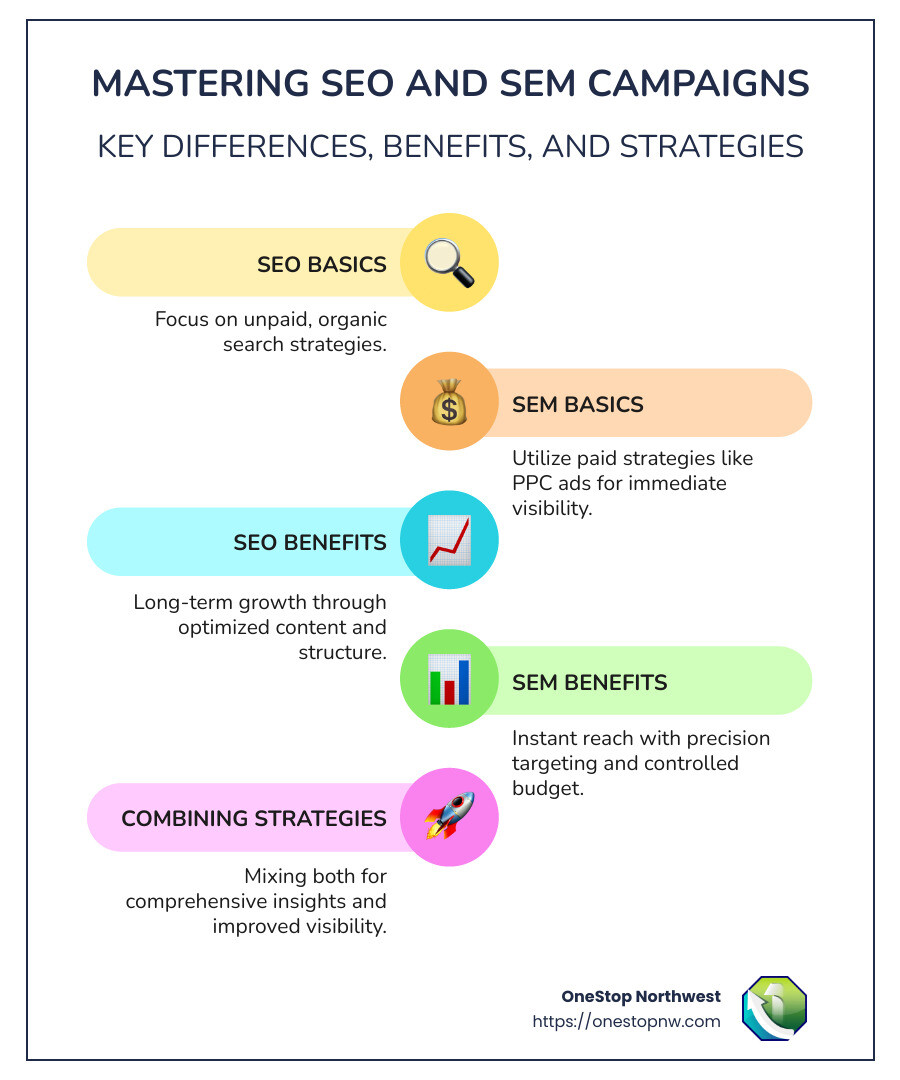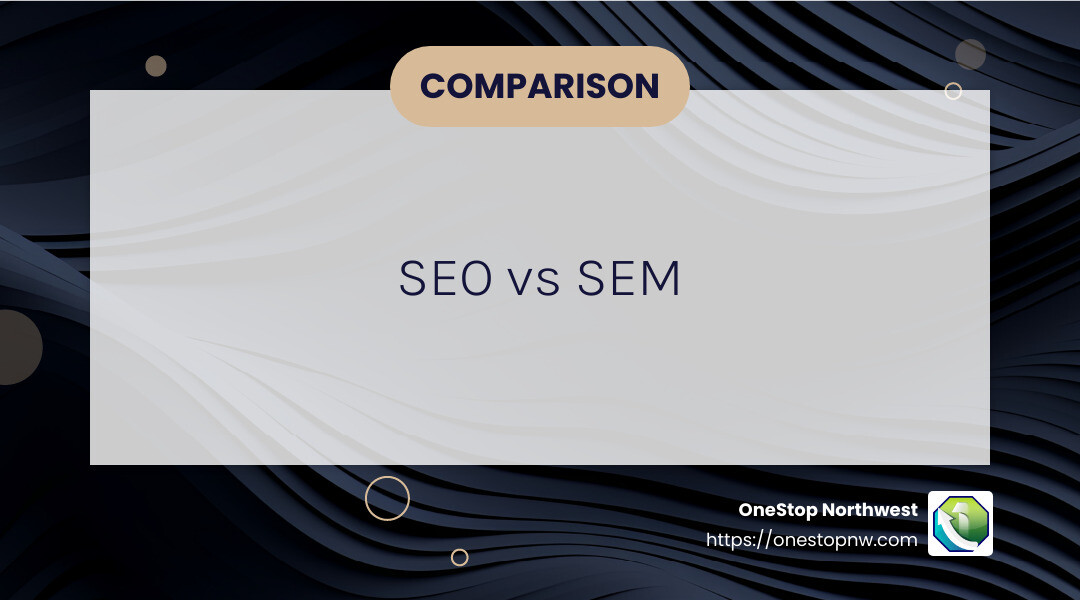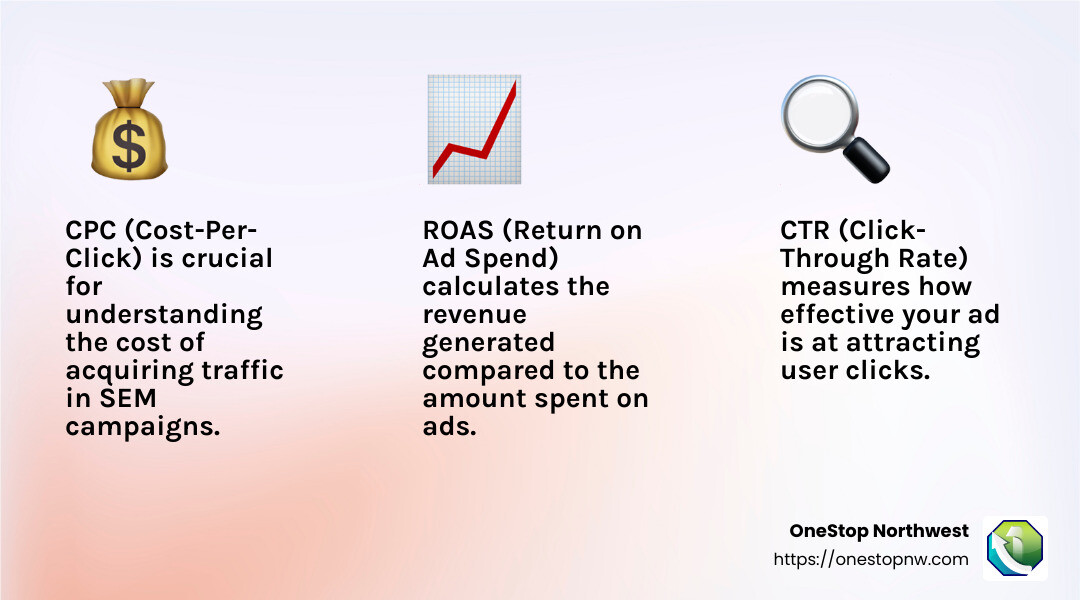SEO SEM Campaigns: 10 Powerful Tips for Success
Mastering SEO SEM Campaigns: Your Quick Guide
Acing your seo sem campaigns is crucial for boosting your business’s online presence. Here’s what you need to know:
-
SEO (Search Engine Optimization): Focuses on improving your visibility through unpaid, or organic, search results. It’s a long-term strategy that includes keyword research and optimizing your website’s content and structure.
-
SEM (Search Engine Marketing): Involves paid strategies like PPC (Pay-Per-Click) ads to increase your website traffic instantly. With SEM, you target specific audiences through keyword bidding and ad placements.
The blend of SEO and SEM not only improves your reach but also ensures that your business stands out from the competition.
In today’s digital marketing world, understanding the balance between these approaches helps your business grow organically and with precision targeting. Search engine algorithms evolve, and staying updated with seo sem campaigns is vital for maintaining your business’s success.
I’m Dylan Cleppe, a seasoned expert in seo sem campaigns, with over 20 years of guiding businesses to thrive online through well-crafted campaigns. Transitioning this knowledge into practice can significantly impact your business’s digital footprint.

Know your seo sem campaigns terms:
– seo and sem marketing
– seo sem services
– digital marketing strategy
Understanding SEO and SEM
Navigating digital marketing often begins with understanding the key players: SEO and SEM. These two strategies form the backbone of any successful online presence. Let’s break them down.
What is SEO?
Search Engine Optimization (SEO) is all about improving your website to rank higher in organic search results. It’s like planting seeds for long-term growth. Here’s how it works:
-
Organic Traffic: SEO focuses on attracting visitors naturally, without paying for ads. This means optimizing your site so it appears in search results when someone looks for related keywords.
-
On-Page SEO: This involves tweaking elements on your website like title tags, meta descriptions, and content quality. The goal is to make your pages relevant and valuable to users searching for specific terms.
-
Off-Page SEO: This is about building your site’s authority through links from other reputable websites. Think of it as networking—when other sites link to you, it shows search engines that you’re a trustworthy source.
-
Technical SEO: This ensures that search engines can easily crawl and index your site. It includes improving site speed, mobile friendliness, and security.
-
User Interaction Signals: How users engage with your site also affects your rankings. High bounce rates might signal that your content isn’t meeting user needs, prompting search engines to lower your ranking.
What is SEM?
Search Engine Marketing (SEM) takes SEO a step further by integrating paid strategies. Here’s what makes SEM stand out:
-
Paid Ads: Unlike SEO, SEM involves paying for visibility. You can place ads on search engines to appear at the top of search results instantly.
-
PPC (Pay-Per-Click): This is a common SEM strategy where you pay each time someone clicks on your ad. It’s a fast way to drive traffic, but it requires careful budget management.
-
Bidding: SEM involves bidding on keywords. The higher your bid, the better your chances of appearing above competitors in search results.
-
Quality Score: Google evaluates your ads based on relevance and user experience, affecting your ad’s cost and position. A high-quality score can lower costs and improve placement.
-
Ad Copy and Ad Groups: Crafting compelling ad copy and organizing them into targeted ad groups is crucial. It ensures that your ads reach the right audience effectively.
SEO and SEM are not mutually exclusive. In fact, combining them in your seo sem campaigns can maximize your reach. SEO builds a strong foundation, while SEM provides immediate visibility. This synergy ensures your business captures both organic and paid search opportunities.

Understanding the differences and strengths of SEO and SEM is the first step to crafting a successful digital marketing strategy. Up next, we’ll dig deeper into the key components of SEO, starting with keyword research.
Key Components of SEO
When it comes to mastering SEO, understanding its core components is crucial. These elements work together to improve your site’s visibility and drive organic traffic. Let’s explore the essentials: keyword research, on-page optimization, off-page optimization, and technical SEO.
Keyword Research
Keyword research is the foundation of any successful SEO strategy. It’s all about finding what your target audience is searching for. Using keyword tools like Ahrefs’ Keywords Explorer or Google Keyword Planner can help identify popular search terms.
-
Target Audience & Search Intent: Understanding what your audience wants is key. Are they looking for information, or are they ready to buy? Align your keywords with their intent to create content that meets their needs.
-
Keyword Tools: Tools provide insights into search volume, competitiveness, and keyword difficulty. This helps prioritize which terms to focus on for maximum impact.
Example: A local bakery might target keywords like “best cupcakes in Seattle” to attract nearby customers looking for sweet treats.
On-Page Optimization
On-page optimization involves refining the elements on your web pages to improve search engine visibility.
-
Title Tags, Meta Descriptions, and Header Tags: These are critical for signaling to search engines what your page is about. Make sure they include relevant keywords and are compelling to users.
-
Content Quality: High-quality, informative content keeps visitors engaged and encourages them to stay longer on your site. This can improve user interaction signals, which are vital for SEO.
-
Example: Structuring a blog post with clear headings and concise paragraphs helps both users and search engines understand the content better.
Off-Page Optimization
Off-page optimization focuses on building your site’s authority and reputation across the web.
-
Backlinks: High-quality backlinks act like votes of confidence from other sites, boosting your credibility in the eyes of search engines.
-
Social Media and Guest Blogging: Sharing content on social media and writing guest posts on other sites can increase your reach and attract more backlinks.
-
Example: A tech startup could write guest articles for industry blogs, gaining exposure and valuable backlinks.
Technical SEO
Technical SEO ensures that search engines can easily access and index your website. It’s the backbone of a well-optimized site.
-
Site Speed and Mobile Friendliness: Fast-loading, mobile-friendly sites provide a better user experience and are favored by search engines.
-
Site Architecture and Security: A clear site structure helps search engines crawl your site efficiently. Security measures like HTTPS are also crucial for protecting user data and building trust.
-
Example: Implementing a responsive design ensures your site looks great on all devices, which can improve rankings and user satisfaction.
By mastering these key components, you can create a robust SEO strategy that not only attracts visitors but also keeps them engaged. Let’s explore the key components of SEM to understand how paid strategies complement organic efforts.
Key Components of SEM
When diving into Search Engine Marketing (SEM), understanding its key components is essential. These elements are the building blocks of successful SEM campaigns, helping businesses reach their target audience effectively. Let’s break down the core components: ad campaigns, keyword bidding, ad copy, landing pages, and SEM metrics.
Ad Campaigns
Ad campaigns are the backbone of SEM. They involve creating and managing ads on platforms like Google Ads, Bing Ads, and Yahoo Ads. These platforms allow businesses to place ads on search engine results pages, increasing visibility and driving traffic.
- Google Ads is the most popular platform, offering a wide range of targeting options and tools to fine-tune your campaigns.
- Bing Ads and Yahoo Ads provide additional opportunities to reach different audiences, often at a lower cost per click (CPC).
Keyword Bidding
Keyword bidding is a critical part of SEM. It determines how much you’re willing to pay for each click on your ad.
- CPC (Cost-Per-Click): The amount you pay each time someone clicks your ad. It’s essential to find a balance between cost and potential return.
- Bidding Strategies: These can vary from manual bidding, where you set the CPC, to automated strategies that optimize bids based on your goals.
- Budget Control: Setting a strict budget ensures you don’t overspend. You can adjust bids based on performance to maximize ROI.
Ad Copy
Creating compelling ad copy is crucial for capturing attention and driving clicks.
- Compelling Content: Your ad must grab attention quickly. Focus on benefits and a strong call to action.
- CTR (Click-Through Rate): A high CTR indicates that your ad is relevant and engaging. It’s a key factor in your ad’s Quality Score.
- Quality Score: Google’s rating of your ad’s relevance and quality. A higher score can lower your CPC and improve ad placement.
Landing Pages
Once a user clicks your ad, they land on a specific page. This landing page should be optimized for conversions.
- Conversion Rates (CVR): The percentage of visitors who complete a desired action, like making a purchase. A high CVR indicates an effective landing page.
- User Experience: Ensure the landing page is easy to steer, loads quickly, and matches the ad’s promise.
- A/B Testing: Experiment with different layouts, headlines, and calls to action to see what works best.
SEM Metrics
To measure the success of your SEM campaigns, track key performance metrics:
- CPC: Helps you understand the cost of acquiring traffic.
- CTR: Indicates how well your ad attracts clicks.
- CVR: Shows how effectively your landing page converts visitors.
- ROAS (Return on Ad Spend): The revenue generated from your ad campaign compared to the amount spent.

By focusing on these components, you can craft seo sem campaigns that are both effective and efficient. Let’s explore the differences between SEO and SEM to determine which strategy may be best for your business.
SEO vs SEM: Which to Focus On?
Choosing between SEO and SEM is a common dilemma for businesses aiming to maximize their online presence. Both strategies have unique advantages and can be custom to fit different business needs. Let’s dive into when to focus on SEO, SEM, or a combination of both in your seo sem campaigns.
When to Focus on SEO
Limited Budget: If you’re a startup or small business with a tight budget, SEO is a great choice. It requires an upfront investment of time and effort but can lead to sustainable growth without ongoing costs per click.
Long-Term Growth: SEO is a long-term strategy. Once your site ranks well, it continues to attract organic traffic without additional costs. This makes it ideal for businesses looking to build a strong online presence over time.
Content Creation and Link Building: If you’re skilled in creating high-quality content and building backlinks, SEO can be highly effective. These elements are crucial for improving your site’s authority and search rankings.
When to Focus on SEM
Immediate Results: SEM provides instant visibility. As soon as your ad campaigns go live, you start seeing traffic. This is crucial for time-sensitive promotions or new product launches.
Consistent Ad Budget: If you have a steady budget for advertising, SEM allows for precise control over your spending. You can set daily limits and adjust bids to ensure cost-effectiveness.
Ad Management and Landing Page Testing: SEM requires ongoing management. Testing different ads and landing pages helps optimize conversion rates and ROI. If you have the resources to manage and test campaigns, SEM can be very rewarding.
When to Combine SEO and SEM
Comprehensive Strategy: Many businesses find success in combining both strategies. This approach maximizes visibility by capturing both organic and paid traffic.
Increased Visibility: By appearing in both organic and paid search results, you dominate the search engine results page, ensuring your brand is consistently visible to potential customers.
Data Insights: Integrating data from both SEO and SEM provides valuable insights into audience behavior and preferences. These insights can refine your overall marketing strategy and improve performance.
In summary, whether you choose SEO, SEM, or both, depends on your business goals, budget, and resources. A balanced approach often yields the best results, leveraging the strengths of both strategies to create effective seo sem campaigns.
Tips and Tricks for Successful SEO and SEM Campaigns
Creating successful SEO and SEM campaigns requires a blend of best practices, continuous optimization, and strategic adjustments. Let’s explore some actionable tips for both SEO and SEM, and how combining these strategies can maximize your return on investment (ROI).
SEO Tips
High-Quality Content: Content is king in SEO. Focus on creating valuable, informative, and engaging content that answers your audience’s questions. According to Investopedia, high-quality content should demonstrate expertise, authoritativeness, and trustworthiness (EEAT).
Keyword Placement: Use keyword research tools to identify the right keywords, then strategically place them in your content, title tags, and meta descriptions. This helps search engines understand the relevance of your pages.
Backlink Strategies: Building high-quality backlinks is crucial for improving your site’s authority. Engage in guest blogging, collaborate with influencers, and leverage social media to gain reputable links. As highlighted in the research, off-page SEO activities like backlinking are key to boosting your site’s credibility.
SEM Tips
Effective Ad Copy: Craft compelling ad copy that resonates with your target audience. Use strong calls-to-action (CTAs) and ensure your ad copy aligns with the search intent of your keywords. As Sophia Tang from Zeralabs suggests, optimizing ad copy and landing pages can significantly improve ad placements and lower costs.
Targeted Keywords: Choose keywords that are highly relevant to your products or services. Use tools like Google Ads to refine your keyword strategy, ensuring your ads reach the right audience at the right time.
Budget Management: Monitor and adjust your budget regularly. Set daily limits and tweak bids based on performance metrics such as click-through rates (CTR) and conversion rates (CVR). This ensures your SEM campaigns remain cost-effective and efficient.
Combining SEO and SEM
Synergy and Complementary Strategies: SEO and SEM are not mutually exclusive. By combining them, you can leverage their strengths to create a more comprehensive digital marketing strategy. For instance, while SEO builds long-term organic visibility, SEM provides immediate traffic and insights.
Maximizing ROI: Use data from both SEO and SEM to make informed decisions. Integrate insights from SEM campaigns to improve your SEO strategy, such as using keyword performance data to optimize content and on-page elements.
Continuous Monitoring and Adjustment: The digital landscape is dynamic. Regularly monitor your campaigns and be prepared to adjust your strategies in response to changes in search engine algorithms or market conditions. This proactive approach helps you stay ahead of the competition and maintain effective seo sem campaigns.
By following these tips and tricks, you can improve the effectiveness of your SEO and SEM efforts, ensuring your digital marketing campaigns drive meaningful results and growth.
Frequently Asked Questions about SEO and SEM Campaigns
What is an SEO campaign?
An SEO campaign is a strategic effort to improve a website’s visibility in organic search engine results. The main goal is to increase traffic by optimizing various elements of the site. Key components include:
- Keyword Research: Identifying terms your target audience searches for.
- On-Page Optimization: Enhancing elements like title tags, meta descriptions, and content quality.
- Off-Page Optimization: Building backlinks and improving site authority.
- Technical SEO: Ensuring the site is crawlable, fast, and secure.
The ultimate aim is to boost rankings for relevant keywords, leading to more organic traffic and potential conversions.
What does SEM stand for in SEO?
SEM, or Search Engine Marketing, is an umbrella term that includes both SEO and paid advertising strategies like PPC (Pay-Per-Click). While SEO focuses on organic search results, SEM encompasses paid search efforts, allowing businesses to place ads in search engine results. This dual approach ensures both immediate visibility through paid ads and long-term growth via organic optimization.
What is an example of a SEM campaign?
A successful SEM campaign often involves a mix of well-planned strategies. For instance, a local restaurant might use Google Ads to target keywords like “best pizza in Seattle.” Here’s how a typical campaign might unfold:
- Keyword Bidding: The restaurant bids on relevant keywords to ensure their ads appear when potential customers search for pizza in their area.
- Ad Copy: Crafting compelling ad text that highlights special offers or unique features, encouraging users to click.
- Landing Pages: Directing clicks to a dedicated landing page with a menu, location, and online ordering options.
- Monitoring Metrics: Using tools like Google Analytics to track metrics such as click-through rates (CTR) and return on ad spend (ROAS).
By continuously optimizing these elements based on performance data, the restaurant can effectively attract more customers and increase revenue. This approach illustrates how SEM campaigns can drive immediate results, making them an integral part of a comprehensive digital marketing strategy.
Conclusion
In the changing landscape of digital marketing, mastering SEO and SEM campaigns is essential for businesses aiming to boost online visibility and drive success. Both strategies offer unique benefits that, when combined, create a powerful synergy capable of maximizing return on investment (ROI).
SEO focuses on long-term growth by improving organic search visibility. It involves optimizing your website’s content and structure to rank higher in search results, ultimately attracting more visitors without the ongoing cost of paid ads. By targeting the right keywords, enhancing on-page elements, and building high-quality backlinks, businesses can steadily increase their online presence.
On the other hand, SEM provides immediate visibility through paid search ads. It allows businesses to target specific keywords and demographics, ensuring that their ads appear in front of potential customers at the right time. With careful management of ad copy, keyword bidding, and landing pages, SEM campaigns can quickly drive traffic and conversions.
OneStop Northwest understands the importance of integrating both SEO and SEM into a cohesive digital marketing strategy. Our expertise in SEO optimization, custom web design, and digital marketing ensures that your business is equipped to steer this complex landscape. By leveraging our services, you can achieve digital marketing success and stay ahead of the competition.
In summary, the key to successful digital marketing lies in balancing the strengths of both SEO and SEM. This approach not only improves visibility but also provides valuable insights into audience behavior, helping you make informed decisions. As the digital world continues to change, staying agile and adaptive will ensure your business thrives in the competitive online environment. Partner with us at OneStop Northwest, and let’s start on a journey toward digital marketing excellence together.

